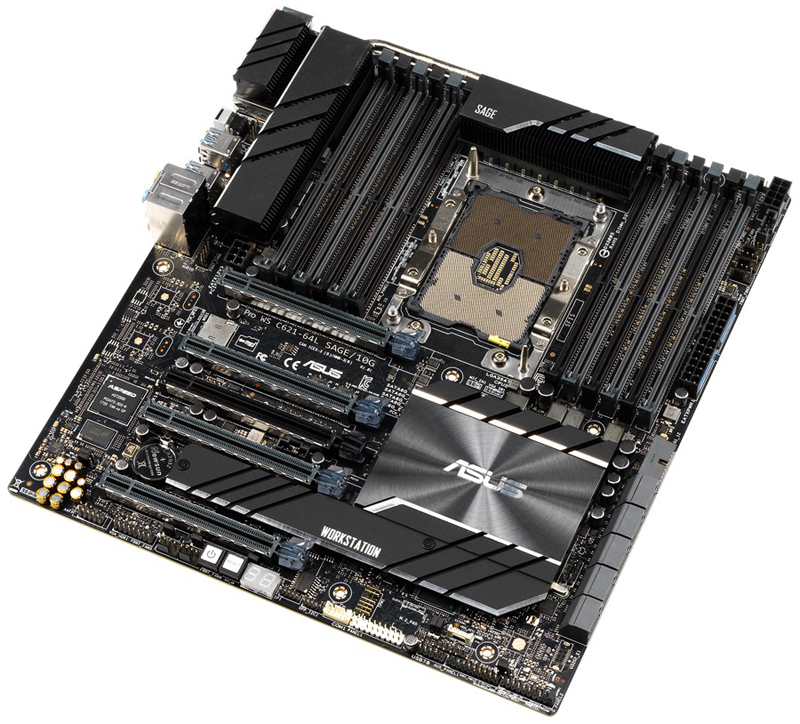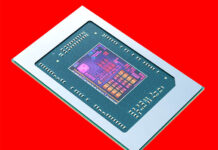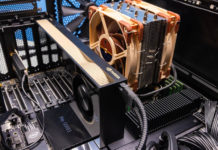ASUS Pro WS C621-64L SAGE/10G Motherboard Power Consumption
Power consumption can vary a significant amount depending on processors used and the number of HDDs/SSDs/Expansion cards used. Here we test just a primary system.

For our tests, we use the AIDA64 Stress test which allows us to stress all aspects of the system. ASUS Pro WS C621-64L SAGE/10G motherboard with Intel Xeon W-3275 uses over 75watts less than the Dominus Extreme which is a considerable amount for just the motherboard changing.
OS Idle: 85W
AIDA64 Stress Test: 366W
Supermicro did a bit better at the maximum power consumption, but the ASUS platform did better at idle.
Final Words
The ASUS Pro WS C621-64L SAGE/10G will be perhaps the most widely used Xeon W-3200 series platforms in ASUS’s WS line up. Here we get a great selection of processors for this motherboard, from Intel Xeon’s to Workstation class processors like the W-3275 we used. With 12 RAM slots, one can max this motherboard memory with 128GB RDIMM’s and M series SKUs. We also find the dual-port Intel X550-AT2 10GbE LAN controller to be a big plus vs a single Aquantia AQC-107 10G port found on the ROG Dominus Extreme.

One thing we do find lacking in the ASUS Pro WS C621-64L SAGE/10G is storage options. There is only one M.2 NVMe slot, and no U.2 ports. One would use the M.2 NVMe slot for the operating system and after that only SATA ports are available. To fit additional fast storage options a PCIe slot would have to be used which would cut into GPU space. With that said, if a system would only be using two GPUs’s the additional PCIe slots would be available for fast storage expansion cards.
We also get remote management with ASMB9-iKVM which many enterprise users require. In a platform like this that may see remote IT management, or may turn into a server role after it is done as a workstation, this is a great feature to have.
At this time the ASUS Pro WS C621-64L SAGE/10G is retailing for approximately $760. On one hand, this is almost $100 over competing motherboards. The addition of the dual Intel X550 10Gbase-T network ports undoubtedly adds to the cost. Still, it is significantly less expensive than the ROG Dominus Extreme and is designed to use the Xeon W-3200’s 64x PCIe lanes or a standard Xeon Scalable processor.
We think that if you are shopping for a Xeon W-3200 series platform, the ASUS Pro WS C621-64L SAGE/10G should be high on your list of options to consider. Its mix of server and workstation features is excellent.




Don’t buy this board, why? Because of the ASMB9-iKVM.
I currently have a Asus X299 PRO/SE motherboard with the same ASMB9-iKVM and it’s practically useless. All sensors show critical, always, even all sorts of voltages (system is fine). The GUI also sucks.
Taking over the console does not work when using a separate GPU instead of the onboard which makes it pretty much useless.
Also had many problems at the beginning when the system woulden’t pass POST without a couple of resets but this was fixed in a later BIOS.
No more Asus ‘Pro’ motherboards for me.
Only one M.2.
Its hard to find out how does this board stands out – everything is typical.
their ipmi(x99,x299) is indeed terrible, I had problems saving ip configuration(“unknown error” on save), working with smash-clp that had none of the gui pages(no sensors, no logs) and it did not work with ipmitool (over kcs) well – changes failed save. couple of times the ipmi interface stopped responding to its ip address and need to be power cycled.
What about Thunderbolt 3? That’s very important for a lot of the workstation market. Looks like you’ll need to lose the x4 PCIe slot for that, so you’re left with only 4 slots. I’m typing this from a Supermicro X10DRG-Q based workstation that is almost five years old. It has six PCIe cards installed, and I still have one more remaining if I need it (which I might soon). I couldn’t do that on this Asus board. Also, a new Asus Xeon W-3200 system is only about 30% faster by these benchmarks. I know this is single-socket, but to me it just underscores how underwhelming the progress has been on Intel workstation platforms. I definitely would’ve upgraded if there had been something interesting.
I would really like to see some Epyc 7002-based *workstation* solutions (not server). That would be exciting.
We use ASMB9 and it’s just the SP-X rebranded. I think the special part about this motherboard is 64 PCIe lanes from the CPU with more from the PCH for NVMe drives.
@Tyler:”I would really like to see some Epyc 7002-based *workstation* solutions (not server). That would be exciting.”
And you couldn’t be bothered to do a Google search for “Epyc workstation mainboard”? There are enough options, albeit for the 7001 platform. However, they are supposed to be compatible with 7002. And you are essentially only missing on PCIe 4 which Intel don’t have anyway.
Also, why would you think a server mainboard is not suitable for a workstation?
@Nikolay Mihaylov: “Also, why would you think a server mainboard is not suitable for a workstation?”
Because of orientation of RAM slots. For workstation I prefer vertical orientation while for server obviously horizontal. There is no single Epyc board which would support 700*2* and yet provide vertical RAM slots orientation. Or have you found any?
@Tyler: “I would really like to see some Epyc 7002-based *workstation* solutions (not server). That would be exciting.”
Me too, but, it looks like AMD is preparing something for Threadripper. Rumored 3 chipsets make me curious if WRX80 will really be for workstation. Rumored capability of supporting (L)RDIMMS (besidees UDIMM ECC) and in 8-channel manner allows some hope here. So let’s see in the future…
@KarelG: “Because of orientation of RAM slots.”
I’m sorry but this is the most ridiculous excuse I’ve ever heard.
This motherboard is awesome, but Intel did go wrong with cpu lineup/segmentation with constant adjustements. Best is a xeon W3200 but when looking at xeon W2200 the cpu is no more interesting…